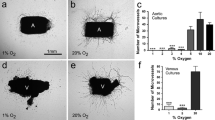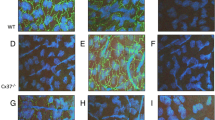Abstract
Downregulation of endothelial connexins has been shown to result in impaired angiogenesis. Isoprenaline is known to upregulate Cx43 in cardiomyocytes. Effects of isoprenaline on endothelial connexins are unknown. We wanted to investigate whether isoprenaline might induce upregulation of connexins Cx37, Cx40, or Cx43 in human endothelial cells and whether it may promote angiogenesis. Human umbilical vein endothelial cells (HUVECs) were cultured until confluence (5 days) and subsequently seeded in Matrigel in vitro angiogenesis assays for 18 h. During the entire cell culture and angiogenesis period, cells were treated with vehicle or isoprenaline (100 nM). Finally, the resulting angiogenetic network was investigated (immuno)histologically. Moreover, expression of Cx37, Cx40, and Cx43 was determined by Western blot. In addition, we measured functional intercellular gap junction coupling by dye injection using patch clamp technique. Isoprenaline resulted in significantly enhanced expression of endothelial Cx43 and to a lower degree of Cx40 and Cx37. The number of coupling cells was significantly increased. Regarding angiogenesis, we observed significantly enhanced formation of branches and a higher complexity of the tube networks with more branches/length. Isoprenaline increases endothelial connexin expression and intercellular coupling and promotes tube formation.







Similar content being viewed by others
References
Burnier L, Fontana P, Angelillo-Scherrer A, Kwak BR (2009) Intercellular communication in atherosclerosis. Physiology (Bethesda) 24:36–44
Ciccarelli M, Sorriento D, Cipolletta E, Santulli G, Fusco A, Zhou RH, Eckhart AD, Peppel K, Koch WJ, Trimarco B, Iaccarino G (2011) Impaired neoangiogenesis in β2-adrenoceptor gene-deficient mice: restoration by intravascular human β2-adrenoceptor gene transfer and role of NFκB and CREB transcription factors. Br J Pharmacol 162(3):712–721
de Wit C, Roos F, Bolz SS, Kirchhoff S, Kruger O, Willecke K, Pohl U (2000) Impaired conduction of vasodilation along arterioles in connexin40-deficient mice. Circ Res 86:649–655
de Wit C, Boettcher M, Schmidt VJ (2008) Signaling across myoendothelial gap junctions–fact or fiction? Cell Commun Adhes 15(3):231–245
Duerrschmidt N, Hagen A, Gaertner C, Wermke A, Nowicki M, Spanel-Borowski K, Stepan H, Mohr FW, Dhein S (2012) Nicotine effects on human endothelial intercellular communication via α4β2 and α3β2 nicotinic acetylcholine receptor subtypes. Naunyn Schmiedeberg’s Arch Pharmacol 385(6):621–632
Ferro A, Queen LR, Priest RM, Xu B, Ritter JM, Poston L, Ward JP (1999) Activation of nitric oxide synthase by beta 2-adrenoceptors in human umbilical vein endothelium in vitro. Br J Pharmacol 126(8):1872–1880
Gärtner C, Ziegelhöffer B, Kostelka M, Stepan H, Mohr FW, Dhein S (2012) Knock-down of endothelial connexins impairs angiogenesis. Pharmacol Res 65(3):347–357
Haussig S, Schubert A, Mohr FW, Dhein S (2008) Sub-chronic nicotine exposure induces intercellular communication failure and differential down-regulation of connexins in cultured human endothelial cells. Atherosclerosis 196(1):210–218
Hervé JC, Dhein S (2010) Peptides targeting gap junctional structures. Curr Pharm Des 16(28):3056–3070
Ishii M, Mueller I, Nakajima T, Pasquale EB, Ogawa K (2011) EphB signaling inhibits gap junctional intercellular communication and synchronized contraction in cultured cardiomyocytes. Basic Res Cardiol 106(6):1057–1068
Lamy S, Lachambre MP, Lord-Dufour S, Béliveau R (2010) Propranolol suppresses angiogenesis in vitro: inhibition of proliferation, migration, and differentiation of endothelial cells. Vasc Pharmacol 53(5–6):200–208
Langlois S, Cowan KN, Shao Q, Cowan BJ, Laird DW (2008) Caveolin-1 and -2 interact with connexin43 and regulate gap junctional intercellular communication in keratinocytes. Mol Biol Cell 19(3):912–928
Laranjo S, Costa G, Paramés F, Freitas I, Martins JD, Trigo C, Pinto FF (2014) The role of propranolol in the treatment of infantile hemangioma. Rev Port Cardiol 33(5):289–295
Liao Y, Day KH, Damon DN, Duling BR (2001) Endothelial cell-specific knockout of connexin 43 causes hypotension and bradycardia in mice. Proc Natl Acad Sci U S A 98:9989–9994
Looft-Wilson RC, Billaud M, Johnstone SR, Straub AC, Isakson BE (2012) Interaction between nitric oxide signaling and gap junctions: effects on vascular function. Biochim Biophys Acta 1818(8):1895–1902
Morawietz H, Rueckschloss U, Niemann B, Duerrschmidt N, Galle J, Hakim K, Zerkowski HR, Sawamura T, Holtz J (1999) Angiotensin II induces LOX-1, the human endothelial receptor for oxidized low-density lipoprotein. Circulation 100:899–902
Phillips RJ, Lokmic Z, Crock CM, Penington A (2014) Infantile haemangiomas that failed treatment with propranolol: clinical and histopathological features. J Paediatr Child Health 50(8):619–625
Rengo G, Zincarelli C, Femminella GD, Liccardo D, Pagano G, de Lucia C, Altobelli GG, Cimini V, Ruggiero D, Perrone-Filardi P, Gao E, Ferrara N, Lymperopoulos A, Koch WJ, Leosco D (2012) Myocardial β(2) -adrenoceptor gene delivery promotes coordinated cardiac adaptive remodelling and angiogenesis in heart failure. Br J Pharmacol 166(8):2348–2361
Sagi L, Zvulunov A, Lapidoth M, Ben Amitai D (2014) Efficacy and safety of propranolol for the treatment of infantile hemangioma: a presentation of ninety-nine cases. Dermatology 228(2):136–144
Salameh A, Dhein S (2005) Pharmacology of gap junctions. New pharmacological targets for treatment of arrhythmia, seizure and cancer? Biochim Biophys Acta 1719(1–2):36–58
Salameh A, Dhein S (2011) Adrenergic control of cardiac gap junction function and expression. Naunyn Schmiedeberg’s Arch Pharmacol 383(4):331–346
Salameh A, Polontchouk L, Dhein S, Hagendorff A, Pfeiffer D (2003) Chronic regulation of the expression of the gap junction protein connexin 43 in transfected HeLa cells. Naunyn Schmiedeberg’s Arch Pharmacol 368(1):33–40
Salameh A, Frenzel C, Boldt A, Rassler B, Glawe I, Schulte J, Mühlberg K, Zimmer HG, Pfeiffer D, Dhein S (2006) Subchronic alpha- and beta-adrenergic regulation of cardiac gap junction protein expression. FASEB J 20(2):365–367
Salameh A, Krautblatter S, Karl S, Blanke K, Gomez DR, Dhein S, Pfeiffer D, Janousek J (2009) The signal transduction cascade regulating the expression of the gap junction protein connexin43 by beta-adrenoceptors. Br J Pharmacol 158(1):198–208
Sexl V, Mancusi G, Baumgartner-Parzer S, Schütz W, Freissmuth M (1995) Stimulation of human umbilical vein endothelial cell proliferation by A2-adenosine and beta 2-adrenoceptors. Br J Pharmacol 114(8):1577–1586
Simon AM, McWhorter AR (2002) Vascular abnormalities in mice lacking the endothelial gap junction proteins connexin37 and connexin40. Dev Biol 251:206–220
Stati T, Musumeci M, Maccari S, Massimi A, Corritore E, Strimpakos G, Pelosi E, Catalano L, Marano G (2014) β-Blockers promote angiogenesis in the mouse aortic ring assay. J Cardiovasc Pharmacol 64(1):21–27
Theis M, de Wit C, Schlaeger TM, Eckardt D, Krüger O, Döring B, Risau W, Deutsch U, Pohl U, Willecke K (2001) Endothelium-specific replacement of the connexin43 coding region by a lacZ reporter gene. Genesis 29(1):1–13
Xia Y, Gong KZ, Xu M, Zhang YY, Guo JH, Song Y, Zhang P (2009) Regulation of gap-junction protein connexin 43 by beta-adrenergic receptor stimulation in rat cardiomyocytes. Acta Pharmacol Sin 30(7):928–934
Author information
Authors and Affiliations
Corresponding author
Additional information
Stefan Dhein and Christiane Gaertner contributed equally.
Rights and permissions
About this article
Cite this article
Dhein, S., Gaertner, C., Georgieff, C. et al. Effects of isoprenaline on endothelial connexins and angiogenesis in a human endothelial cell culture system. Naunyn-Schmiedeberg's Arch Pharmacol 388, 101–108 (2015). https://doi.org/10.1007/s00210-014-1059-0
Received:
Accepted:
Published:
Issue Date:
DOI: https://doi.org/10.1007/s00210-014-1059-0




